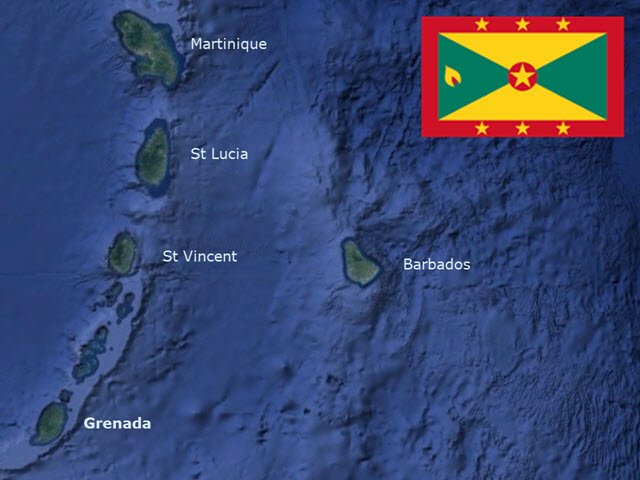
Basic Facts
Capital: St. George’s
People/Customs: There are around 100,000 people on Grenada, Carriacou, and Petit Martinique. Most are descended from African slaves.
Language: English
Climate: In the winter the high is around 81°, the low, 72°. In the summer, the high is 86°, the low, 77°. Hurricane Season is from June to November. This is also the rainy season.
Food/Farming: Grenada is the world’s second largest nutmeg producer, but the island also exports mace, cloves, cinnamon, cacao/chocolate, rum, and bananas. Other tropical fruits like citrus, mangoes, avocados, soursop, breadfruit, sugar apples, and passionfruit are grown for local consumption.
Government: Grenada is an independent nation inside the British Commonwealth.
Currency: The East Caribbean Dollar (EC) is used here.
Art/Music/Culture: Soca and Calypso music are popular here, especially during Carnival (the first week of August). Other holidays include New Year’s Day, Easter Monday, Labour Day, Whit Monday, Emancipation Day, Christmas Day, and Boxing Day.
History
Grenada was sighted by Columbus in 1498, but no colonizers landed until 1609 when English settlers planned to farm tobacco on the island. The native Caribs drove them off the island, but in 1650 a French governor bought Grenada from the natives for hatchets, beads, and brandy. In 1651 French soldiers attempted to enslave the Caribs, but rather than become captives and be taken to Europe, most jumped off of a huge cliff, now called Leaper’s Hill or Caribs’ Leap. The French imported African slaves and plantations of indigo, tobacco, coffee, cocoa, and sugar thrived in the fertile soil of Grenada. England and France fought over the island until 1783 when the Treaty of Paris was signed and Britain took over Grenada. After slavery was abolished in 1834, the plantation became obsolete and major production of sugar stopped.
In 1877 Grenada became a crown colony, and gained independence as a nation inside British Commonwealth in 1974. In 1979, Maurice Bishop, as part of the New Jewel Movement, led a coup against the government, which was perceived to be corrupt. He became prime minister of the People’s Revolutionary Government. He was popular because he tried to improve common people’s lives, starting schools, medical clinics, and farmer’s co-ops. Division within the party led to a military overthrow and he was placed under house arrest in 1983. There was public outcry and a large crowd of people stormed Fort George. The military fired into the crowd and Bishop was taken prisoner and executed with several of his followers. During the period of unrest that followed, the United States and several Caribbean nations got involved, invading Grenada and attempting to quell the violence and reinstate a democratic leadership. Elections were held again in 1985 and Herbert Blaize became prime minister. The people responsible for Maurice Bishop’s murder were sentenced to life in prison. To this day, Bishop is viewed as a national hero, and the United States is admired for its role in the conflict.
Land forms/Flora and Fauna
Breadfruit, flamboyant, and palm are the most numerous trees, and Mona monkeys, 9-banded armadillos, opossums, hummingbirds, mongooses, and bats can be found on the island. The island is mountainous with tropical rainforest. Several smaller islands, the largest of which are Carriacou and Petit Martinique are also part of Grenada.
Things to do
Snorkel in Carriacou and Petit Martinique, as well as the underwater sculpture park in Dragon Bay, go to the Beach at Grande Anse, Morne Rouge, or La Sagesse, hike in the Grand Etang National Park, go on a nutmeg factory tour, chocolate tour, or rum distillery tour, and swim in Concord Falls or Seven Sisters Falls.
Bibliography
Bendure, Glenda and Ned Friary. “Grenada.” Lonely Planet Guide to the Eastern Caribbean, 2nd Edition. 1998: Lonely Planet, Hawthorn, Australia.
